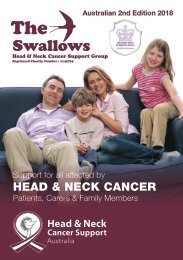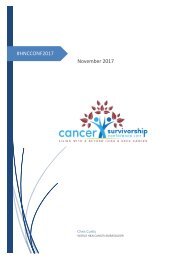Cancer Survivorship Delegate Programme 2017
Create successful ePaper yourself
Turn your PDF publications into a flip-book with our unique Google optimized e-Paper software.
Quality of Life Definition<br />
‘The general well-being of a person, defined in<br />
terms of health and happiness, rather than wealth.’<br />
Even when a condition can be totally cured, there is a period of reduced<br />
quality of life that most of us would just as soon avoid. It is our<br />
responsibility to improve the quality of life for ourselves and others. A<br />
healthy lifestyle leads to a better quality of life.’<br />
Source: Collins English Dictionary. Copyright © HarperCollins Publishers<br />
Why Quality of Life post- treatment can be hard to predict…<br />
The goal of treatment for head and neck cancers is to control the disease.<br />
However, doctors should also be concerned about preserving the function<br />
of the affected areas as much as they can, and helping the patient<br />
return to normal activities as soon as possible after treatment. Rehabilitation<br />
is a very important part of this process. The goals of rehabilitation<br />
depend on the extent of the disease and the treatment that a patient<br />
has received.<br />
Depending on the location of the cancer and the type of treatment,<br />
rehabilitation may include physical therapy, dietary counselling, speech<br />
therapy, and/or learning how to care for a stoma. A stoma is an opening<br />
into the windpipe through which a patient breathes after a laryngectomy,<br />
(surgery to remove the larynx).<br />
Sometimes, especially with cancer of the oral cavity, a patient may need<br />
reconstructive and plastic surgery to rebuild bones or tissues.<br />
However, reconstructive surgery may not always be possible<br />
because of damage to the remaining tissue from the original<br />
surgery or from radiation therapy. If reconstructive surgery is not<br />
possible, a prosthodontist may be able to make a prosthesis (an artificial<br />
dental and/or facial part) to restore satisfactory swallowing, speech, and<br />
appearance. Patients will receive training on how to use the device.<br />
Patients who have trouble speaking after treatment may need speech<br />
therapy. Often a speech-language pathologist will visit the patient in<br />
the hospital to plan therapy and teach speech exercises or alternative<br />
methods of speaking. Speech therapy usually continues after the patient<br />
returns home.<br />
Eating and swallowing may be difficult after treatment for head and<br />
neck cancer. Some patients receive nutrients directly into a vein after<br />
surgery or need a feeding tube until they can eat on their own. A feeding<br />
tube is a flexible plastic tube that is passed into the stomach through<br />
the nose or an incision in the abdomen. A nurse or speech-language<br />
pathologist can help patients learn how to swallow again after surgery.<br />
When the doctors say, ‘Good news. You are free of<br />
cancer.’ the hard part of the journey starts. That is why<br />
the conference title is ‘Living with and Beyond <strong>Cancer</strong>.’<br />
<strong>Cancer</strong> <strong>Survivorship</strong> Front Cover.indd 6 31/10/<strong>2017</strong> 13:22













